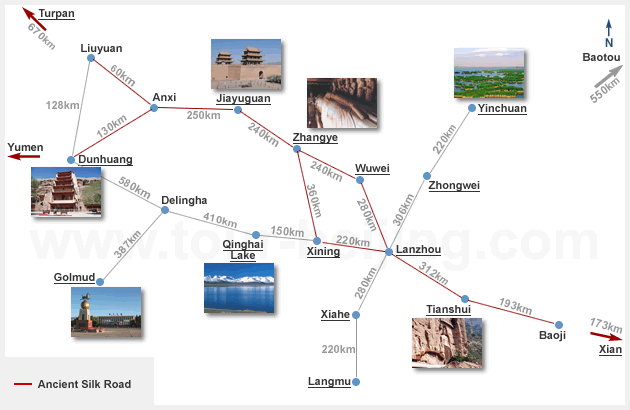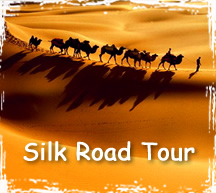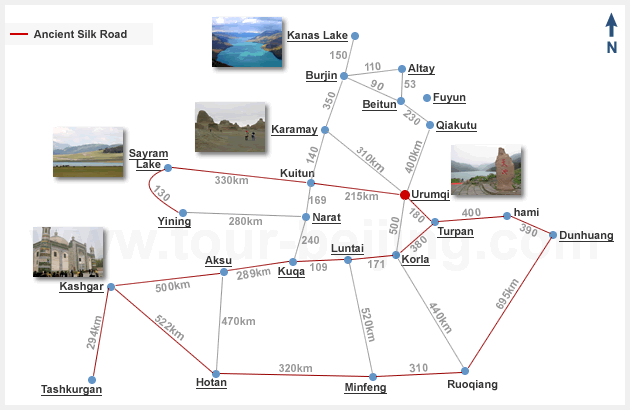Major Cities & Attractions Along China Silk Road
Silk Road Map (Gansu)
Silk Road Map (Xinjiang)

Xian:
 The ancient city lies in the center of Xian, which is circled by the city wall. The ancient city proper has four must-to-see attractions. The Great Islamic Mosque was set up during the Song Dynasty (960-1279). The Bell Tower was first set up in the Ming Dynasty (1384). The Drum Tower was built in 1380. And the Provincial Museum has huge number of cultural relics with the famous Forest of Tablet Stones dating back to the Han, Wei, Sui, Tang, Song, Yuan, Ming, and Qing dynasties. The Terra-cotta Warriors and Horse of Xi'an, is the greatest archeological found of this century. The other landmark like Big Wild Goose Pagoda mirrors China's long history.
The ancient city lies in the center of Xian, which is circled by the city wall. The ancient city proper has four must-to-see attractions. The Great Islamic Mosque was set up during the Song Dynasty (960-1279). The Bell Tower was first set up in the Ming Dynasty (1384). The Drum Tower was built in 1380. And the Provincial Museum has huge number of cultural relics with the famous Forest of Tablet Stones dating back to the Han, Wei, Sui, Tang, Song, Yuan, Ming, and Qing dynasties. The Terra-cotta Warriors and Horse of Xi'an, is the greatest archeological found of this century. The other landmark like Big Wild Goose Pagoda mirrors China's long history.Lanzhou:
 Lanzhou is in the shape of a narrow & long valley circled by hills and the Yellow River. It is the capital city of Gansu Province with a population of 2.83 million people, one of the largest cities in the northwest.The city is named Lanzhou because it is located in the central section of Gansu Province, with Gaolan Mountain Range to its south. It was an important base around 1,400 years of Hexi Corridor. Now it is still a key stretch of the Silk Road.
Lanzhou is in the shape of a narrow & long valley circled by hills and the Yellow River. It is the capital city of Gansu Province with a population of 2.83 million people, one of the largest cities in the northwest.The city is named Lanzhou because it is located in the central section of Gansu Province, with Gaolan Mountain Range to its south. It was an important base around 1,400 years of Hexi Corridor. Now it is still a key stretch of the Silk Road.Wuwei:
 In the past Wuwei was called Liangzhou. It was an important post on the ancient Silk Road. It is located between Qilian Mountains to the southwest and Tenggeli Desert in the north. Today Wuwei is a historical and cultural city. Its anicent Liangzhou used to be a prosperous city with great number of of merchants moving the Western Region. Monk Xuanzang once preached Buddhist doctrines here. Wuwei has many historical sites, such as the Eastern Han Tomb and Confucius Temple.
In the past Wuwei was called Liangzhou. It was an important post on the ancient Silk Road. It is located between Qilian Mountains to the southwest and Tenggeli Desert in the north. Today Wuwei is a historical and cultural city. Its anicent Liangzhou used to be a prosperous city with great number of of merchants moving the Western Region. Monk Xuanzang once preached Buddhist doctrines here. Wuwei has many historical sites, such as the Eastern Han Tomb and Confucius Temple.Zhangye:
 Zhangye is a town with a long glorious hisory. It is located about 450km northwest of the capital Lanzhou of Gansu Province. It is a most small station on the Lanzhou-Urumqi rail line. This city is famous for its wine --Zhangye Rice Wine ,Zhangye Nan Wine.This small city is home to China’s largest Reclining Buddha – 35 meters long, 7.5 meters high.
Zhangye is a town with a long glorious hisory. It is located about 450km northwest of the capital Lanzhou of Gansu Province. It is a most small station on the Lanzhou-Urumqi rail line. This city is famous for its wine --Zhangye Rice Wine ,Zhangye Nan Wine.This small city is home to China’s largest Reclining Buddha – 35 meters long, 7.5 meters high.Jiayuguan Pass:
 Situated 4 kilometers west of Jiayuguan city on the northwest part of Gansu Province, Jiayuguan Pass is the western end of the Great Wall of the Ming Dynasty. It is also the most important and best-preserved pass among the over thousand passes of the GReat Wall built during in Ming Dynasty. It is well known as "Impregnable Pass Under Heaven" . It took about 160 years to establish this strategic outpost.
Situated 4 kilometers west of Jiayuguan city on the northwest part of Gansu Province, Jiayuguan Pass is the western end of the Great Wall of the Ming Dynasty. It is also the most important and best-preserved pass among the over thousand passes of the GReat Wall built during in Ming Dynasty. It is well known as "Impregnable Pass Under Heaven" . It took about 160 years to establish this strategic outpost.Dunhuang:
 Dunhuang City is located to the west part of Hexi Corridor, Gansu Province. It was once called Shazhou (sandbank) in ancient time. Dunhuang City is famous for its historical culture of China and an important ancient city on Silk Road in ancient time. The caves of Mogaoku have showcased the achievements of ancient architecture, painting and sculpture. This is the treasure-house of arts, biggest and richest in content reserved in China now. Now main communication of Dunhuang City is highway. It has airliner connection with Beijing, Lanzhou, Xi"an and Urumqi cities etc.
Dunhuang City is located to the west part of Hexi Corridor, Gansu Province. It was once called Shazhou (sandbank) in ancient time. Dunhuang City is famous for its historical culture of China and an important ancient city on Silk Road in ancient time. The caves of Mogaoku have showcased the achievements of ancient architecture, painting and sculpture. This is the treasure-house of arts, biggest and richest in content reserved in China now. Now main communication of Dunhuang City is highway. It has airliner connection with Beijing, Lanzhou, Xi"an and Urumqi cities etc.Yangguan Pass:
 Yangguan Pass lies 75 kilometers southwest of Dunhuang. It was originally set up by Emperor Wu in Hang Dynasty as one of the two passes protecting Dunhuang from the west. The other is Yumen Pass. Today it look quite ruined with most of the sections buried in the sands. Today the Yangguan Pass has been replaced by boundless sands and several beacon towers.
Yangguan Pass lies 75 kilometers southwest of Dunhuang. It was originally set up by Emperor Wu in Hang Dynasty as one of the two passes protecting Dunhuang from the west. The other is Yumen Pass. Today it look quite ruined with most of the sections buried in the sands. Today the Yangguan Pass has been replaced by boundless sands and several beacon towers.Hami:
 Called as the eastern gate of Xinjiang, Hami was an important town on the northern route of the Old Silk Road. It is also famous for its Hami melons. in Hami, you can find many beacon towers, ancient cities, tombs, stone tablets and rock carvings. Some beacon towers still lie along the northern and central sectins of the Old Silk Road. The Karlik Glacier in Hami, at 4,888 meters above sea level, is still an unclimbed "virgin" peak. The Ice and Snow Tour in Hami is a hot winter holiday program. You can reach Hami by highway and railway.
Called as the eastern gate of Xinjiang, Hami was an important town on the northern route of the Old Silk Road. It is also famous for its Hami melons. in Hami, you can find many beacon towers, ancient cities, tombs, stone tablets and rock carvings. Some beacon towers still lie along the northern and central sectins of the Old Silk Road. The Karlik Glacier in Hami, at 4,888 meters above sea level, is still an unclimbed "virgin" peak. The Ice and Snow Tour in Hami is a hot winter holiday program. You can reach Hami by highway and railway. Turpan:
 Turpan is located in the Turpan Basin at the southern foot of the Tianshan Mountains. The City has a population of nearly 200,000, most of whom are Uygurs. Called Gaochang in ancient times, it was a major stop on the northern route of the Old Silk Road and is the hottest, lowest and driest place in China. It is also the hottest place in China. Turpan is most famous for its splendid grapes. Every household has a ventilated barn on the roof, and some of the world's finest grapes are produced here. Turpan is about 182 km from Urumqi and 2.5 hours by drive.
Turpan is located in the Turpan Basin at the southern foot of the Tianshan Mountains. The City has a population of nearly 200,000, most of whom are Uygurs. Called Gaochang in ancient times, it was a major stop on the northern route of the Old Silk Road and is the hottest, lowest and driest place in China. It is also the hottest place in China. Turpan is most famous for its splendid grapes. Every household has a ventilated barn on the roof, and some of the world's finest grapes are produced here. Turpan is about 182 km from Urumqi and 2.5 hours by drive.Urumqi:
 Urumqi means "A beautiful Pasture land " in ancient Mongolian. It is the educational, cultural and political centre of Xinjiang Uygur Autonomous Region. The city now has a population of 1 million and 80% of them are Han. The city is located on the west of Bogda Mountain( a part of of the Tianshan Mountain) . For the past 2000 years, this area around Urumqi has been lush pastures inhabited by many minorities who raised sheep and cattle.The best season to visit Xinjiang is between July and October.
Urumqi means "A beautiful Pasture land " in ancient Mongolian. It is the educational, cultural and political centre of Xinjiang Uygur Autonomous Region. The city now has a population of 1 million and 80% of them are Han. The city is located on the west of Bogda Mountain( a part of of the Tianshan Mountain) . For the past 2000 years, this area around Urumqi has been lush pastures inhabited by many minorities who raised sheep and cattle.The best season to visit Xinjiang is between July and October.Loulan:
 Loulan was a town on the central Old Silk Road where the Han Dynasty (206 BC – AD 220) central government built its administrative organization. It was the most prosperous city till 4th dynasty in with a population of over 10,000. It was learn that merchants of all nationalities met here. After the fourth century Loulan declined rapidly. There are no written records of Loulan extant after the fifth century. In Tang Dynasty, Monk Xuanzang wrote in his travel books on his pilgrimage to India, "The town and houses still lie there, but there are nobody around." Archaeologists say that a change the river course and wars and deterioration of the land caused the city's disappearance.
Loulan was a town on the central Old Silk Road where the Han Dynasty (206 BC – AD 220) central government built its administrative organization. It was the most prosperous city till 4th dynasty in with a population of over 10,000. It was learn that merchants of all nationalities met here. After the fourth century Loulan declined rapidly. There are no written records of Loulan extant after the fifth century. In Tang Dynasty, Monk Xuanzang wrote in his travel books on his pilgrimage to India, "The town and houses still lie there, but there are nobody around." Archaeologists say that a change the river course and wars and deterioration of the land caused the city's disappearance.Korla:
 It is the capital of the Bayangol Mongol Autonomous Prefecture with an area of 478,700 square kilometers. it is located in the southern Xinjiang, in the Tarim Basin and the southern foot of the Tianshan Mountains. It is about 471 kilometers from Urumqi. It has rich attractions. Bosten Lake--Bosten is the biggest freshwater lake in Xinjiang, covering an area of 960 square kilometers;Bayandulak Grassland-- 270 kilometers from Korla,a summer-season grassland;Tiemen Pass (The Iron Gate)--the pass was an important point along the route into the Tarim Basin in the ancient times.
It is the capital of the Bayangol Mongol Autonomous Prefecture with an area of 478,700 square kilometers. it is located in the southern Xinjiang, in the Tarim Basin and the southern foot of the Tianshan Mountains. It is about 471 kilometers from Urumqi. It has rich attractions. Bosten Lake--Bosten is the biggest freshwater lake in Xinjiang, covering an area of 960 square kilometers;Bayandulak Grassland-- 270 kilometers from Korla,a summer-season grassland;Tiemen Pass (The Iron Gate)--the pass was an important point along the route into the Tarim Basin in the ancient times.Kuqa (Kucha):
 Kuqa is located in southern Xinjiang at the southern foot of the Tianshan Mountains. In the past it was an important town on the central Old Silk Road. It is now under the administration of of Aksu Prefecture. It was influenced by multiple cultures and the Qiuci civilization is tje most famous! it was where Qiuci City was once formed. Just like other old towns, Qiuci City was discovered after having disappeared for over 10 centuries. Kuqa is full of Buddhist cave sites and ancient ruins. The Kizil and Kumtura caves, both located on the Muzart River still keep 3rd and 4th century treasures of fresco painting.
Kuqa is located in southern Xinjiang at the southern foot of the Tianshan Mountains. In the past it was an important town on the central Old Silk Road. It is now under the administration of of Aksu Prefecture. It was influenced by multiple cultures and the Qiuci civilization is tje most famous! it was where Qiuci City was once formed. Just like other old towns, Qiuci City was discovered after having disappeared for over 10 centuries. Kuqa is full of Buddhist cave sites and ancient ruins. The Kizil and Kumtura caves, both located on the Muzart River still keep 3rd and 4th century treasures of fresco painting.Aksu:
 Aksu Prefecture is easily reached by highway, railway and air. It has many cultural sites, such as Buddhist grottoes likethe Kizil, Kumutura, Mazabeg and Simsem grottoes. Among the sights of natural sites in Aksu Prefecture include Mount Tomur -- site of China's largest modern glacier, the Taklimakan Desert, the Mystic Grand Canyon of the Tianshan Mountains and "Holy Forestry".
Aksu Prefecture is easily reached by highway, railway and air. It has many cultural sites, such as Buddhist grottoes likethe Kizil, Kumutura, Mazabeg and Simsem grottoes. Among the sights of natural sites in Aksu Prefecture include Mount Tomur -- site of China's largest modern glacier, the Taklimakan Desert, the Mystic Grand Canyon of the Tianshan Mountains and "Holy Forestry".Kashgar (Kashi):
 It is lying in the southwest of Xinjiang. From the west, this is the first stop for the arrivals on land routes from Pakistan and Kirgyzistan. As a vital stop on the Silk Road, this remote city is about some 4,000 km from Beijing. Today, the city still manages to meet most visitors's requesy with modernization and architectural decline. The old streets, restaurants and markets here are great for exploring. The city is particularly busy between May and October--filled with merchants and traders from Pakistan and Kirgyistan.Abakh Khoja Tomb,Idgar Mosque,Kashgar Old Town and Sunday Bazzar are the four musts for first visitors.
It is lying in the southwest of Xinjiang. From the west, this is the first stop for the arrivals on land routes from Pakistan and Kirgyzistan. As a vital stop on the Silk Road, this remote city is about some 4,000 km from Beijing. Today, the city still manages to meet most visitors's requesy with modernization and architectural decline. The old streets, restaurants and markets here are great for exploring. The city is particularly busy between May and October--filled with merchants and traders from Pakistan and Kirgyistan.Abakh Khoja Tomb,Idgar Mosque,Kashgar Old Town and Sunday Bazzar are the four musts for first visitors.Hotan:
 Hotan is located in the southern Tarim Basin. It was once the site of the Yutian Kingdom which had dominated the southern route of the Old Silk Road.Yutian was the first area in China to take Buddhism. Tang Dynasty monk Xuanzang in his travel book, mentioned that there were over 100 Buddhist temples in Yutian that accommodated about 5,000 monks. Hotan is well known for jade. The best quality is so called "as white as sheep fat". Most of the seals of Chinese emperors were made of Hotan jade. Hotan's many historical sites include the Niya city ruins, also called "Pompei of the Orient." Hotan has no railway. To get there, you have to take flight from Urumuqi by a weekly flight.Or you may tale the bus from Kashgar.
Hotan is located in the southern Tarim Basin. It was once the site of the Yutian Kingdom which had dominated the southern route of the Old Silk Road.Yutian was the first area in China to take Buddhism. Tang Dynasty monk Xuanzang in his travel book, mentioned that there were over 100 Buddhist temples in Yutian that accommodated about 5,000 monks. Hotan is well known for jade. The best quality is so called "as white as sheep fat". Most of the seals of Chinese emperors were made of Hotan jade. Hotan's many historical sites include the Niya city ruins, also called "Pompei of the Orient." Hotan has no railway. To get there, you have to take flight from Urumuqi by a weekly flight.Or you may tale the bus from Kashgar.Questions & Answers:





